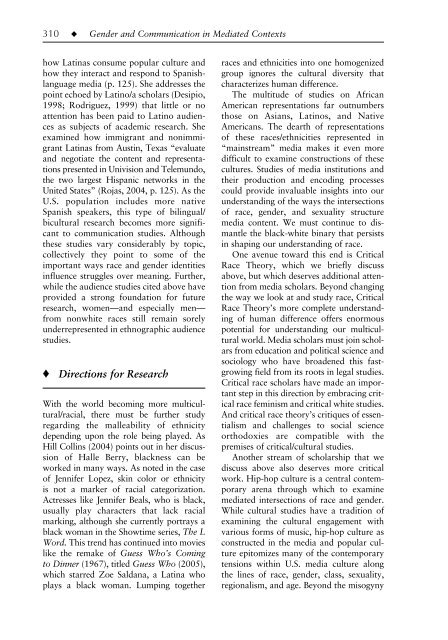Gender, race, and media representation - afghan
Gender, race, and media representation - afghan
Gender, race, and media representation - afghan
Create successful ePaper yourself
Turn your PDF publications into a flip-book with our unique Google optimized e-Paper software.
16-Dow-4973.qxd 6/11/2006 1:42 PM Page 310<br />
310–––◆–––<strong>Gender</strong> <strong>and</strong> Communication in Mediated Contexts<br />
how Latinas consume popular culture <strong>and</strong><br />
how they interact <strong>and</strong> respond to Spanishlanguage<br />
<strong>media</strong> (p. 125). She addresses the<br />
point echoed by Latino/a scholars (Desipio,<br />
1998; Rodriguez, 1999) that little or no<br />
attention has been paid to Latino audiences<br />
as subjects of academic research. She<br />
examined how immigrant <strong>and</strong> nonimmigrant<br />
Latinas from Austin, Texas “evaluate<br />
<strong>and</strong> negotiate the content <strong>and</strong> <strong>representation</strong>s<br />
presented in Univision <strong>and</strong> Telemundo,<br />
the two largest Hispanic networks in the<br />
United States” (Rojas, 2004, p. 125). As the<br />
U.S. population includes more native<br />
Spanish speakers, this type of bilingual/<br />
bicultural research becomes more significant<br />
to communication studies. Although<br />
these studies vary considerably by topic,<br />
collectively they point to some of the<br />
important ways <strong>race</strong> <strong>and</strong> gender identities<br />
influence struggles over meaning. Further,<br />
while the audience studies cited above have<br />
provided a strong foundation for future<br />
research, women—<strong>and</strong> especially men—<br />
from nonwhite <strong>race</strong>s still remain sorely<br />
underrepresented in ethnographic audience<br />
studies.<br />
♦ Directions for Research<br />
With the world becoming more multicultural/racial,<br />
there must be further study<br />
regarding the malleability of ethnicity<br />
depending upon the role being played. As<br />
Hill Collins (2004) points out in her discussion<br />
of Halle Berry, blackness can be<br />
worked in many ways. As noted in the case<br />
of Jennifer Lopez, skin color or ethnicity<br />
is not a marker of racial categorization.<br />
Actresses like Jennifer Beals, who is black,<br />
usually play characters that lack racial<br />
marking, although she currently portrays a<br />
black woman in the Showtime series, The L<br />
Word. This trend has continued into movies<br />
like the remake of Guess Who’s Coming<br />
to Dinner (1967), titled Guess Who (2005),<br />
which starred Zoe Saldana, a Latina who<br />
plays a black woman. Lumping together<br />
<strong>race</strong>s <strong>and</strong> ethnicities into one homogenized<br />
group ignores the cultural diversity that<br />
characterizes human difference.<br />
The multitude of studies on African<br />
American <strong>representation</strong>s far outnumbers<br />
those on Asians, Latinos, <strong>and</strong> Native<br />
Americans. The dearth of <strong>representation</strong>s<br />
of these <strong>race</strong>s/ethnicities represented in<br />
“mainstream” <strong>media</strong> makes it even more<br />
difficult to examine constructions of these<br />
cultures. Studies of <strong>media</strong> institutions <strong>and</strong><br />
their production <strong>and</strong> encoding processes<br />
could provide invaluable insights into our<br />
underst<strong>and</strong>ing of the ways the intersections<br />
of <strong>race</strong>, gender, <strong>and</strong> sexuality structure<br />
<strong>media</strong> content. We must continue to dismantle<br />
the black-white binary that persists<br />
in shaping our underst<strong>and</strong>ing of <strong>race</strong>.<br />
One avenue toward this end is Critical<br />
Race Theory, which we briefly discuss<br />
above, but which deserves additional attention<br />
from <strong>media</strong> scholars. Beyond changing<br />
the way we look at <strong>and</strong> study <strong>race</strong>, Critical<br />
Race Theory’s more complete underst<strong>and</strong>ing<br />
of human difference offers enormous<br />
potential for underst<strong>and</strong>ing our multicultural<br />
world. Media scholars must join scholars<br />
from education <strong>and</strong> political science <strong>and</strong><br />
sociology who have broadened this fastgrowing<br />
field from its roots in legal studies.<br />
Critical <strong>race</strong> scholars have made an important<br />
step in this direction by embracing critical<br />
<strong>race</strong> feminism <strong>and</strong> critical white studies.<br />
And critical <strong>race</strong> theory’s critiques of essentialism<br />
<strong>and</strong> challenges to social science<br />
orthodoxies are compatible with the<br />
premises of critical/cultural studies.<br />
Another stream of scholarship that we<br />
discuss above also deserves more critical<br />
work. Hip-hop culture is a central contemporary<br />
arena through which to examine<br />
<strong>media</strong>ted intersections of <strong>race</strong> <strong>and</strong> gender.<br />
While cultural studies have a tradition of<br />
examining the cultural engagement with<br />
various forms of music, hip-hop culture as<br />
constructed in the <strong>media</strong> <strong>and</strong> popular culture<br />
epitomizes many of the contemporary<br />
tensions within U.S. <strong>media</strong> culture along<br />
the lines of <strong>race</strong>, gender, class, sexuality,<br />
regionalism, <strong>and</strong> age. Beyond the misogyny




